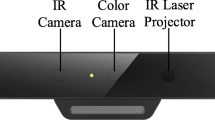Abstract
This paper describes a multiple camera-based method to reconstruct the 3D shape of a human foot. From a foot database, an initial 3D model of the foot represented by a cloud of points is built. The shape parameters, which can characterize more than 92% of a foot, are defined by using the principal component analysis method. Then, using “active shape models”, the initial 3D model is adapted to the real foot captured in multiple images by applying some constraints (edge points’ distance and color variance). We insist here on the experiment part where we demonstrate the efficiency of the proposed method on a plastic foot model, and also on real human feet with various shapes. We propose and compare different ways of texturing the foot which is needed for reconstruction. We present an experiment performed on the plastic foot model and on human feet and propose two different ways to improve the final 3D shape’s accuracy according to the previous experiments’ results. The first improvement proposed is the densification of the cloud of points used to represent the initial model and the foot database. The second improvement concerns the projected patterns used to texture the foot. We conclude by showing the obtained results for a human foot with the average computed shape error being only 1.06 mm.
Similar content being viewed by others
Explore related subjects
Discover the latest articles, news and stories from top researchers in related subjects.References
M. Kouchi. Japanese Body Dimension Data, [Online], Available: http://www.dh.aist.go.jp/research/centered/anthropometry/NIBHdatabook.html.en, December 6, 2007.
K. M. Robinette, H. Daanen, E. Paquet. The Caesar Project: A 3D Surface Anthropometry Survey. In Proceedings of the 2nd International Coference on 3D Digital Imaging and Modeling, IEEE Press, Ottawa, Ont., Canada, pp. 380–386, 1999.
S. Weik. A Passive Full Body Scanner Using Shape from Silhouettes. In Proceedings of the 15th International Conference on Pattern Recognition, IEEE Press, Barcelona, Spain, pp. 1750–1753, 2000.
R. Hartley, A. Zisserman. Multiple View Geometry in Computer Vision, Cambridge University Press, UK, pp. 139–182, 2000.
T. McInerney, D. Terzopoulos. Deformable Models in Medical Image Analysis: A Survey. Medical Image Analysis, vol, 1, no. 2, pp. 91–108, 1996.
T. F. Cootes, C. J. Taylor, D. H. Cooper, J. Graham. Active Shape Models — Their Training and Application. Computer Vision Image Understanding, vol. 61, no. 1, pp. 38–59, 1995.
Y. Wang, L. H. Staib. Boundary Finding with Correspondence Using Statistical Shape Models. In Proceedings of IEEE Coference on Computer Vision and Pattern Recognition, IEEE Press, Santa Barbara, CA, USA, pp.338–345, 1998.
J. Wang, H. Saito, M. Kimura, M. Mochimaru, T. Kanade. Human Foot Reconstruction from Multiple Camera Images with Foot Shape Database. IEICE Transactions on Information and Systems, vol. E89-D, no. 5, pp. 1732–1742, 2006.
J. Y. Bouguet. Complete Camera Calibration Toolbox for Matlab, [Online], Available: http://www.vision.caltech.edu/bouguetj/calib, December 6, 2007.
Author information
Authors and Affiliations
Corresponding author
Additional information
This work was supported by Grant-in-Aid for Scientific Research (C) (No. 17500119).
Edmée Amstutz studied in Centrale Nantes Engineering School in France from 2004 to 2006, and is currently in second year of master course in Department of Computer Science at Keio University, Japan, in a double-degree exchange program.
Her research interests include computer vision, 3D object reconstruction, augmented reality and their human-centered applications for life environment improvement.
Tomoaki Teshima received his B.Eng. and M.Eng. degrees in the field of computer science from Keio University, Japan, in 2005 and 2006.
He is presently a Ph.D. candidate in School of Science for Open Environmental System, Keio University. His research interests include concentrated on computer vision and image processing, especially with a vehicle camera.
Makoto Kimura received B.Eng. M.Eng. and Ph.D. degrees in electrical engineering from Keio University, Japan, in 1995, 1997, and 2002, respectively. He has been working for Digital Human Research Center, National Institute of Advanced Industrial Science and Technology (AIST) as a CREST Researcher of Japan Science and Technology (JST) Agency since 2002. From 1998 to 1999, he was a visiting scholar of the Robotics Institute, CMU, USA.
His research interests include computer vision and image processing.
Masaaki Mochimaru received Ph.D. degree in engineering from Keio University, Japan, in 1993. Then, he became a researcher at National Institute of Bioscience and Human-technology. Since 2001, he has been the deputy director of Digital Human Research Center, National Institute of Advanced Industrial Science and Technology (AIST). He is a member of IEEE Computer Society, Society of Automotive Engineers. He got Ichimura Prize from the New Technology Development Foundation in 2002. His major is biomechanics and ergonomics.
His research interests include measurement and modeling of human body shape and motion.
Hideo Saito received the B. Eng., M.Eng., and Ph.D. degrees in electrical engineering from Keio University, Japan, in 1987, 1989, and 1992, respectively. He has been on the faculty of Department of Electrical Engineering, Keio University, Japan since 1992. From 1997 to 1999, he was a visiting researcher at the Robotics Institute, Carnegie Mellon University, Pittsburgh, PA, where he joined the virtualized reality project. From 2000 to 2003, he was also a researcher with PRESTO, JST. Since 2006, he has been a professor in the Department of Information and Computer Science, Keio University.
He is a member of IEICE, IPSJ, VRST, ITE, IIEEJ, and SICE. His research interests include computer vision, image processing, augmented reality, and human-computer interaction.
Rights and permissions
About this article
Cite this article
Amstutz, E., Teshima, T., Kimura, M. et al. PCA-based 3D shape reconstruction of human foot using multiple viewpoint cameras. Int. J. Autom. Comput. 5, 217–225 (2008). https://doi.org/10.1007/s11633-008-0217-6
Received:
Revised:
Published:
Issue Date:
DOI: https://doi.org/10.1007/s11633-008-0217-6




